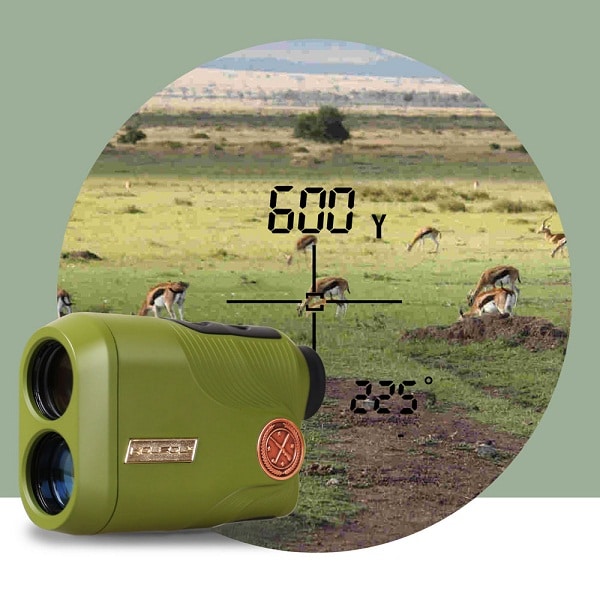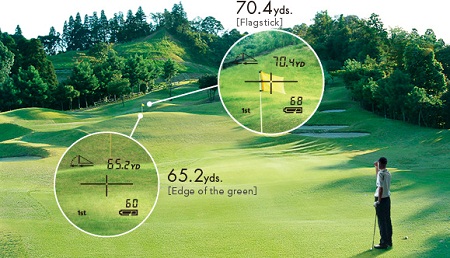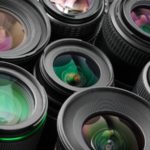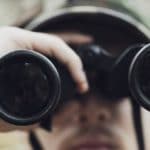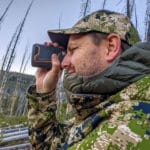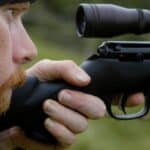Hunting electronics are simply excellent. Most of its users though don’t have an idea how they work or how to repair them when they’re broken.
Rangefinders are no different, and the vast majority of hunters won’t ever try to modify or even understand how their gear works. This is a shame because when you know how they function, you can appreciate how cool they are and how to maximize them.
They all work the same — bouncing a laser beam off a target and measuring how long it takes to reflect the sensor inside the unit.
4 Steps to Find Range
There are four steps on how a laser rangefinder finds your range.
1. Target Identification
The first step to measure the range between you and the target is of course, finding it. This is easy on your end. All you need to do is line up the reticle with the desired target, press the button and wait for the rangefinder to spit out a number.
The problem occurs when the sensor doesn’t detect what exactly you’re pointing at. Interference such as bushes in between you and the target, maybe a tree off to one side, or even other targets on a steel course can throw off the measurement.
There’s never any shortage of stuff to reflect the laser beam back to the unit, especially if you use a rangefinder with an unusually large beam.
2. Divergence
The beam size, called the divergence, is a feature of each model that determines how much a rangefinder “sees.”
It can be explained almost like the dot on a red dot sight. This means that the further you are from the target, the more laser divergence you have and the more the laser rangefinder “sees.”
The way the unit copes with this depends mostly on its cost and design. Most of the cheaper end models have large apertures with small divergence to make sure they collect the data from the beam but can lack accuracy.
The more expensive units use programs called target priority that work by identifying the profile of certain objects, like branches and bushes, and ignoring their signal.
3. Measuring the Reflection
The reflection is measured back at the unit after the laser beam has bounced off. The sensor has an aperture, just like on the beam, that limits some reflected beams that comeback to the unit’s sensor.
The beam comes into the unit and stops a clock that was started when you pressed it. This clock reports to the computer that crunches the numbers to see how far the light traveled by measuring how long it took to get there and back.
One of the biggest problems with the reflection method is that anything can reflect the laser — everything from grass to thick fog.
It’s hard to counter things like this and the measurements can get squirrely. This is the area that the high-end models start to come into their own.
4. Check for Accuracy
Most models display whatever the first reading is that comes back.
This is common on the lower end models that don’t have software or other measures to ensure tight accuracy and proper target identification. Some of the higher end units pulse dozens of measurements a second and compare them.
This can be done by taking a spike of close readings, by averaging the readings the unit is getting, or by looking for a similar reading and picking the median of the cluster.
Whichever way it’s done, these measurements happen quickly. And if you can, you should beam at least two or three measurements to every target you plan on shooting at. Just like measuring with a ruler, things can happen that alter the analysis.
The Brand Differences
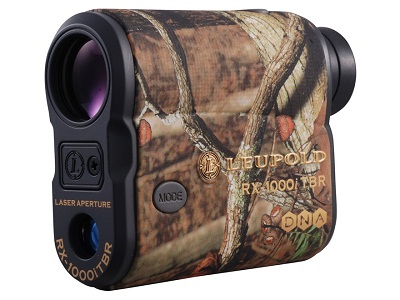
It takes manufacturer highly technical information about the electronics and required specifications to balance the beam divergence with the aperture size, and the careful selection of electronic components inside the unit that make it all work.
That is the primary source of quality and brand difference in this market.
Specialized Ballistic Features
Some laser rangefinders can provide information such as rifle dope, arrow clearance through the bush and the actual flight distance of a projectile. To understand how this works, you must digest these:
- Bullets and arrows do not create lift. Therefore, they must have an arched trajectory.
- External ballistics – the qualities and conditions associated with how projectile flies.
Taking those two things into account, the computer inside the laser rangefinder creates the trajectory of the projectile in mind, and then uses the information collected by the laser beam used in a scan mode, and runs calculation.
These formulas include ways to factor in angles, elevations, and ground distance to find the arching path of the bullet or arrow as it flies and then makes a decision.
This can mean alarming you about a branch in the way or the extreme angle you’re shooting at and predicting the effect on the projectile.
These units are becoming better at predicting relationships between projectiles and targets to make it easier to range further out with greater accuracy and lethality.
Make it Work for You
Knowing how your laser rangefinder works is going to help you by doing several things.
You can predict what the laser will bounce off or before you beam out a laser and you’ll be able to know when something is wrong and diagnose it.
The most common misuse of a laser rangefinder is when you use it at a distance, past 200 yards, and get interference from any number of sources.
Using a general expectation of how far away your target is, using your experience and eyes alongside your rangefinder, can mitigate a lot of problems with bogus measurements.
You can’t go wrong if you pair some critical thinking on using your rangefinder. The technology that goes into these units is incredible and never ceases to amaze hunters every year with just how easy it has become to get an accurate distance using the gear.

